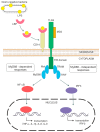Alveolar-Capillary Membrane-Related Pulmonary Cells as a Target in Endotoxin-Induced Acute Lung Injury
- PMID: 30769918
- PMCID: PMC6412348
- DOI: 10.3390/ijms20040831
Alveolar-Capillary Membrane-Related Pulmonary Cells as a Target in Endotoxin-Induced Acute Lung Injury
Abstract
The main function of the lungs is oxygen transport from the atmosphere into the blood circulation, while it is necessary to keep the pulmonary tissue relatively free of pathogens. This is a difficult task because the respiratory system is constantly exposed to harmful substances entering the lungs by inhalation or via the blood stream. Individual types of lung cells are equipped with the mechanisms that maintain pulmonary homeostasis. Because of the clinical significance of acute respiratory distress syndrome (ARDS) the article refers to the physiological role of alveolar epithelial cells type I and II, endothelial cells, alveolar macrophages, and fibroblasts. However, all these cells can be damaged by lipopolysaccharide (LPS) which can reach the airspaces as the major component of the outer membrane of Gram-negative bacteria, and lead to local and systemic inflammation and toxicity. We also highlight a negative effect of LPS on lung cells related to alveolar-capillary barrier and their response to LPS exposure. Additionally, we describe the molecular mechanism of LPS signal transduction pathway in lung cells.
Keywords: acute respiratory distress syndrome; alveolar epithelial cells; alveolar macrophages; bacterial lipopolysaccharide; endothelial cells; fibroblasts.
Conflict of interest statement
The authors declare no conflict of interest.
Figures


Similar articles
-
Adenosine A2B receptor activation stimulates alveolar fluid clearance through alveolar epithelial sodium channel via cAMP pathway in endotoxin-induced lung injury.Am J Physiol Lung Cell Mol Physiol. 2020 Apr 1;318(4):L787-L800. doi: 10.1152/ajplung.00195.2019. Epub 2020 Mar 4. Am J Physiol Lung Cell Mol Physiol. 2020. PMID: 32129084
-
Regulation of alveolar procoagulant activity and permeability in direct acute lung injury by lung epithelial tissue factor.Am J Respir Cell Mol Biol. 2015 Nov;53(5):719-27. doi: 10.1165/rcmb.2014-0179OC. Am J Respir Cell Mol Biol. 2015. PMID: 25884207 Free PMC article.
-
PCTR1 improves pulmonary edema fluid clearance through activating the sodium channel and lymphatic drainage in lipopolysaccharide-induced ARDS.J Cell Physiol. 2020 Dec;235(12):9510-9523. doi: 10.1002/jcp.29758. Epub 2020 Jun 11. J Cell Physiol. 2020. PMID: 32529661
-
Pulmonary surfactant and bacterial lipopolysaccharide: the interaction and its functional consequences.Physiol Res. 2017 Sep 22;66(Suppl 2):S147-S157. doi: 10.33549/physiolres.933672. Physiol Res. 2017. PMID: 28937231 Review.
-
The value of the lipopolysaccharide-induced acute lung injury model in respiratory medicine.Expert Rev Respir Med. 2010 Dec;4(6):773-83. doi: 10.1586/ers.10.71. Expert Rev Respir Med. 2010. PMID: 21128752 Review.
Cited by
-
MDH1 and MDH2 Promote Cell Viability of Primary AT2 Cells by Increasing Glucose Uptake.Comput Math Methods Med. 2022 Sep 14;2022:2023500. doi: 10.1155/2022/2023500. eCollection 2022. Comput Math Methods Med. 2022. Retraction in: Comput Math Methods Med. 2023 Dec 6;2023:9854393. doi: 10.1155/2023/9854393. PMID: 36158123 Free PMC article. Retracted. Review.
-
Inhibition of EZH2 Ameliorates Sepsis Acute Lung Injury (SALI) and Non-Small-Cell Lung Cancer (NSCLC) Proliferation through the PD-L1 Pathway.Cells. 2022 Dec 7;11(24):3958. doi: 10.3390/cells11243958. Cells. 2022. PMID: 36552722 Free PMC article.
-
Biocompatible N-acetyl-nanoconstruct alleviates lipopolysaccharide-induced acute lung injury in vivo.Sci Rep. 2021 Nov 22;11(1):22662. doi: 10.1038/s41598-021-01624-5. Sci Rep. 2021. PMID: 34811378 Free PMC article.
-
Hordenine Protects Against Lipopolysaccharide-Induced Acute Lung Injury by Inhibiting Inflammation.Front Pharmacol. 2021 Sep 1;12:712232. doi: 10.3389/fphar.2021.712232. eCollection 2021. Front Pharmacol. 2021. PMID: 34539399 Free PMC article.
-
NRF1 knockdown alleviates lipopolysaccharide-induced pulmonary inflammatory injury by upregulating DKK3 and inhibiting the GSK-3β/β-catenin pathway.Clin Exp Immunol. 2023 Dec 11;214(1):120-129. doi: 10.1093/cei/uxad071. Clin Exp Immunol. 2023. PMID: 37402316 Free PMC article.
References
Publication types
MeSH terms
Substances
LinkOut - more resources
Full Text Sources

